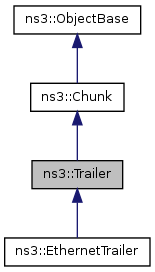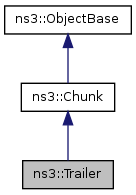Protocol trailer serialization and deserialization. More...
#include <trailer.h>


Public Member Functions | |
| virtual uint32_t | GetSerializedSize (void) const =0 |
| virtual void | Serialize (Buffer::Iterator start) const =0 |
| virtual uint32_t | Deserialize (Buffer::Iterator end)=0 |
| virtual void | Print (std::ostream &os) const =0 |
Static Public Member Functions | |
| static TypeId | GetTypeId (void) |
| This method returns the TypeId associated to ns3::Trailer. | |
Detailed Description
Protocol trailer serialization and deserialization.
Every Protocol trailer which needs to be inserted or removed from a Packet instance must derive from this base class and implement the pure virtual methods defined here.
Member Function Documentation
| virtual uint32_t ns3::Trailer::Deserialize | ( | Buffer::Iterator | end | ) | [pure virtual] |
- Parameters:
-
end an iterator which points to the end of the buffer where the trailer should be read from.
- Returns:
- the number of bytes read.
This method is used by Packet::RemoveTrailer to re-create a trailer from the byte buffer of a packet. The data read is expected to match bit-for-bit the representation of this trailer in real networks. The input iterator points to the end of the area where the data shall be written. This method is thus expected to call Buffer::Iterator::Prev prio to actually reading any data.
Implements ns3::Chunk.
Implemented in ns3::EthernetTrailer.
| virtual uint32_t ns3::Trailer::GetSerializedSize | ( | void | ) | const [pure virtual] |
- Returns:
- the expected size of the trailer.
This method is used by Packet::AddTrailer to store a trailer into the byte buffer of a packet. This method should return the number of bytes which are needed to store the full trailer data by Serialize.
Implemented in ns3::EthernetTrailer.
| static TypeId ns3::Trailer::GetTypeId | ( | void | ) | [static] |
This method returns the TypeId associated to ns3::Trailer.
No Attributes defined for this type.
No TraceSources defined for this type.
Reimplemented from ns3::Chunk.
Reimplemented in ns3::EthernetTrailer.
| virtual void ns3::Trailer::Print | ( | std::ostream & | os | ) | const [pure virtual] |
This method is used by Packet::Print to print the content of a trailer as ascii data to a c++ output stream. Although the trailer is free to format its output as it wishes, it is recommended to follow a few rules to integrate with the packet pretty printer: start with flags, small field values located between a pair of parens. Values should be separated by whitespace. Follow the parens with the important fields, separated by whitespace. i.e.: (field1 val1 field2 val2 field3 val3) field4 val4 field5 val5
Implements ns3::Chunk.
Implemented in ns3::EthernetTrailer.
| virtual void ns3::Trailer::Serialize | ( | Buffer::Iterator | start | ) | const [pure virtual] |
- Parameters:
-
start an iterator which points to where the trailer should be written.
This method is used by Packet::AddTrailer to store a header into the byte buffer of a packet. The data written is expected to match bit-for-bit the representation of this trailer in real networks. The input iterator points to the end of the area where the data shall be written. This method is thus expected to call Buffer::Iterator::Prev prior to actually writing any data.
Implemented in ns3::EthernetTrailer.
The documentation for this class was generated from the following files:
- src/common/trailer.h
- doc/introspected-doxygen.h
 1.7.1
1.7.1